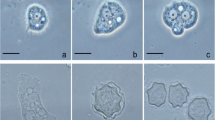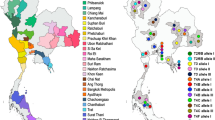Abstract
Free-living amoebae of the genus Acanthamoeba are worldwide present in natural and artificial environments, and are also clinically important, as causative agents of diseases in humans and other animals. Acanthamoeba comprises several species, historically assigned to one of the three groups based on their cyst morphology, but presently recognized as at least 20 genotypes (T1-T20) on the basis of their nuclear 18S ribosomal RNA (rRNA) gene (18S rDNA) sequences. While strain identification may usually be achieved targeting short (<500 bp) 18S ribosomal DNA (rDNA) fragments, the use of full-length gene sequences (>2200 bp) is necessary for correct genotype description and reliable molecular phylogenetic inference. The genotype T15, corresponding to Acanthamoeba jacobsi, is the only genotype described on the basis of partial sequences (~1500 bp). While this feature does not prevent the correct identification of the strains, having only partial sequences renders the genotype T15 not completely defined and may furthermore affect its position in the Acanthamoeba molecular tree. Here, we complete this gap, by obtaining full-length 18S rDNA sequences from eight A. jacobsi strains, genotype T15. Morphologies and physiological features of isolated strains are reported. Molecular phylogeny based on full 18S rDNA confirms some previous suggestions for a genetic link between T15 and T13, T16, and T19, with T19 as sister-group to T15.





Similar content being viewed by others
References
Alves JMP, Gusmão CX, Teixeira MM, Freitas D, Foronda AS, Affonso HT (2000) Random amplified polymorphic DNA profiles as a tool for the characterization of Brazilian keratitis isolates of the genus Acanthamoeba. Braz J Med Biol Res 33:19–26
Armand B, Motazedian MH, Asgari Q (2016) Isolation and identification of pathogenic free-living amoeba from surface and tap water of Shiraz City using morphological and molecular methods. Parasitol Res 115:63–68
Booton GC, Kelly DJ, Chu Y, Seal DV, Houang E, Lam DSC, Byers TJ, Fuerst PA (2002) 18S ribosomal DNA typing and tracking of Acanthamoeba species isolates from corneal scrape specimens, contact lenses, lens cases, and home water supplies of Acanthamoeba keratitis patients in Hong Kong. J Clin Microbiol 40:1621–1625
Booton GC, Visvesvara GS, Byers TJ, Kelly DJ, Fuerst PA (2005) Identification and distribution of Acanthamoeba species genotypes associated with nonkeratitis infections. J Clin Microbiol 43:1689–1693
Cabello-Vílchez AM, Martín-Navarro CM, López-Arencibia A, Reyes-Batlle M, González AC, Guerra H, Gotuzzo E, Valladares B, Piñero JE, Lorenzo-Morales J (2014) Genotyping of potentially pathogenic Acanthamoeba strains isolated from nasal swabs of healthy individuals in Peru. Acta Trop 130:7–10
Conza L, Pagani SC, Gaia V (2013) Presence of Legionella and free-living amoebae in composts and bioaerosols from composting facilities. PLoS One 8:e68244
Corsaro D, Venditti D (2010) Phylogenetic evidence for a new genotype of Acanthamoeba (Amoebozoa, Acanthamoebida). Parasitol Res 107:233–238
Corsaro D, Venditti D (2011) More Acanthamoeba genotypes: limits to use rDNA fragments to describe new genotype. Acta Protozool 50:51–56
Corsaro D, Walochnik J, Köhsler M, Rott MB (2015) Acanthamoeba misidentification and multiple labels: redefining genotypes T16, T19 and T20, and proposal for Acanthamoeba micheli sp. nov. (genotype T19). Parasitol Res 114:2481–2490
Curson RTM, Brown TJ (1978) Use of cell cultures as an indicator of pathogenicity of free-living amoebae. J Clin Pathol 31:1–11
Di Cave D, Monno R, Bottalico P, Guerriero S, D’Amelio S, D’Orazi C, Berrilli F (2009) Acanthamoeba T4 and T15 genotypes associated with keratitis infections in Italy. Eur J Clin Microbiol Infect Dis 28:607–612
Di Cave D, D'Alfonso R, Dussey Comlavi KA, D'Orazi C, Monno R, Berrilli F (2014) Genotypic heterogeneity based on 18S-rRNA gene sequences among Acanthamoeba isolates from clinical samples in Italy. Exp Parasitol 145:S46–S49
Duarte JL, Furst C, Klisiowicz DR, Klassen G, Costa AO (2013) Morphological, genotypic, and physiological characterization of Acanthamoeba isolates from keratitis patients and the domestic environment in Vitoria, Espírito Santo, Brazil. Exp Parasitol 135:9–14
Evyapan G, Koltas IS, Eroglu F (2015) Genotyping of Acanthamoeba T15: the environmental strain in Turkey. Trans R Soc Trop Med Hyg 109:221–224
Fabres LF, Rosa dos Santos SP, Benitez LB, Rott MB (2016) Isolation and identification of Acanthamoeba spp. from thermal swimming pools and spas in Southern Brazil. Acta Parasitol 61:221–227
Flint JA, Dobson PJ, Robinson BS (2003) Genetic analysis of forty isolates of Acanthamoeba group III by multilocus isoenzyme electrophoresis. Acta Protozool 42:317–324
Fritsche TR, Gautom RK, Seyerdirshti S, Bergeron DL, Lindquist TD (1993) Occurrence of bacterial endosymbionts in Acanthamoeba spp. isolated from corneal and environmental specimens and contact lenses. J Clin Microbiol 31:1122–1126
Gast RJ, Fuerst PA, Byers TJ (1994) Discovery of group I introns in the nuclear small subunit ribosomal RNA genes of Acanthamoeba. Nucleic Acids Res 22:592–596
Geisen S, Fiore-Donno AM, Walochnik J, Bonkowski M (2014) Acanthamoeba everywhere: high diversity of Acanthamoeba in soils. Parasitol Res 113:3151–3158
Griffin JL (1972) Temperature tolerance of pathogenic and nonpathogenic free-living amoebae. Science 178:869–870
Grün AL, Stemplewitz B, Scheid P (2014) First report of an Acanthamoeba genotype T13 isolate as etiological agent of a keratitis in humans. Parasitol Res 113:2395–2400
Hajialilo E, Behnia M, Tarighi F, Niyyati M, Rezaeian M (2016) Isolation and genotyping of Acanthamoeba strains (T4, T9, and T11) from amoebic keratitis patients in Iran. Parasitol Res 115:3147–3151
Hedberg A, Johansen SD (2013) Nuclear group I introns in self-splicing and beyond. Mob DNA 4:17
Hewett MK, Robinson BS, Monis PT, Saint CP (2003) Identification of a new Acanthamoeba 18S rRNA gene sequence type, corresponding to the species Acanthamoeba jacobsi Sawyer, Nerad and Visvesvara, 1992 (Lobosea: Acanthamoebidae). Acta Protozool 42:325–329
Huang SW, Hsu BM (2010) Isolation and identification of Acanthamoeba from Taiwan spring recreation areas using culture enrichment combined with PCR. Acta Trop 115:282–287
Johansen S, Haugen P (2001) A new nomenclature of group I introns in ribosomal DNA. RNA 7:935–936
Kao PM, Hsu BM, Chen NH, Huang KH, Huang SW, King KL, Chiu YC (2012) Isolation and identification of Acanthamoeba species from thermal spring environments in southern Taiwan. Exp Parasitol 130:354–358
Kao PM, Chou MY, Tao CW, Huang WC, Hsu BM, Shen SM, Fan CW, Chiu YC (2013) Diversity and seasonal impact of Acanthamoeba species in a subtropical rivershed. Biomed Res Int 2013:405794
Khan NA (2009) Acanthamoeba–biology and pathogenesis. Caister Academic Press, Norfolk, Great Britain, 290 pp
Khan NA, Jarroll EL, Paget TA (2001) Acanthamoeba can be differentiated by the polymerase chain reaction and simple plating assays. Curr Microbiol 43:204–208
Kiss C, Barna Z, Vargha M, Török JK (2014) Incidence and molecular diversity of Acanthamoeba species isolated from public baths in Hungary. Parasitol Res 113:2551–2557
Koltas IS, Eroglu F, Erdem E, Yagmur M, Tanır F (2015) The role of domestic tap water on Acanthamoeba keratitis in non-contact lens wearers and validation of laboratory methods. Parasitol Res 114:3283–3289
Landell MF, Salton J, Caumo K, Broetto L, Rott MB (2013) Isolation and genotyping of free-living environmental isolates of Acanthamoeba spp. from bromeliads in southern Brazil. Exp Parasitol 134:290–294
Maciver SK, Asif M, Simmen MW, Lorenzo-Morales J (2013) A systematic analysis of Acanthamoeba genotype frequency correlated with source and pathogenicity: T4 is confirmed as a pathogen-rich genotype. Eur J Protistol 49:217–221
Maghsood AH, Sissons J, Rezaian M, Nolder D, Warhurst D, Khan NA (2005) Acanthamoeba genotype T4 from the UK and Iran and isolation of the T2 genotype from clinical isolates. J Med Microbiol 54:755–759
Magnet A, Henriques-Gil N, Galván-Diaz AL, Izquiedo F, Fenoy S, Del Aguila C (2014) Novel Acanthamoeba 18S rRNA gene sequence type from an environmental isolate. Parasitol Res 113:2845–2850
Marciano-Cabral F, Cabral G (2003) Acanthamoeba spp. as agents of disease in humans. Clin Microbiol Rev 16:273–307
Michel F, Westhof E (1990) Modelling of the three-dimensional architecture of group I catalytic introns based on comparative sequence analysis. J Mol Biol 216:585–610
Montalbano Di Filippo M, Santoro M, Lovreglio P, Monno R, Capolongo C, Calia C, Fumarola L, D'Alfonso R, Berrilli F, Di Cave D (2015) Isolation and molecular characterization of free-living amoebae from different water sources in Italy. Int J Environ Res Public Health 12:3417–3427
Nagyová V, Nagy A, Janecek S, Timko J (2010a) Morphological, physiological, molecular and phylogenetic characterization of new environmental isolates of Acanthamoeba spp. from the region of Bratislava, Slovakia. Biologia 65:81–91
Nagyová V, Nagy A, Timko J (2010b) Morphological, physiological and molecular biological characterisation of isolates from first cases of Acanthamoeba keratitis in Slovakia. Parasitol Res 106:861–872
Niyyati M, Nazar M, Haghighi A, Nazemalhosseini Mojarad E (2012) Screening of recreational areas of rivers for potentially pathogenic free-living amoebae in the suburbs of Tehran, Iran. J Water Health 10:140–146
Niyyati M, Saberi R, Latifi A, Lasjerdi Z (2016) Distribution of Acanthamoeba genotypes isolated from recreational and therapeutic geothermal water sources in Southwestern Iran. Environ Health Insights 10:69–74
Page FC (1988) A new key to freshwater and soil Gymnamoebae. Freshwater Biological Association, Ambleside, Cumbria, p 92–97
Pussard M, Pons R (1977) Morphologie de la paroi kystique et taxonomie du genre Acanthamoeba (Protozoa, Amoebida). Protistologica 8:557–598
Qvarnstrom Y, Nerad TA, Visvesvara GS (2013) Characterization of a new pathogenic Acanthamoeba species, A. byersi n. sp., isolated from a human with fatal amoebic encephalitis. J Eukaryot Microbiol 60:626–633
Risler A, Coupat-Goutaland B, Pélandakis M (2013) Genotyping and phylogenetic analysis of Acanthamoeba isolates associated with keratitis. Parasitol Res 112:3807–3816
Rivera WL, Adao DE (2008) Identification of the 18S-ribosomal-DNA genotypes of Acanthamoeba isolates from the Philippines. Ann Trop Med Parasitol 102:671–677
Sawyer TK, Visvesvara GS, Harke BA (1977) Pathogenic amoebas from brackish and ocean sediments, with a description of Acanthamoeba hatchetti, n. sp. Science 196:1324–1325
Sawyer TK, Nerad TA, Visvesvara GS (1992) Acanthamoeba jacobsi sp. n. (Protozoa: Acanthamoebidae) from sewage contaminated ocean sediments. J Helminthol Soc Wash 59:223–226
Schroeder JM, Booton GC, Hay J, Niszl IA, Seal DV, Markus MB, Fuerst PA, Byers TJ (2001) Use of subgenic 18S ribosomal DNA PCR and sequencing for genus and genotype identification of Acanthamoebae from humans with keratitis and from sewage sludge. J Clin Microbiol 39:1903–1911
Schroeder-Diedrich JM, Fuerst PA, Byers TJ (1998) Group-I introns with unusual sequences occur at three sites in nuclear 18S rRNA genes of Acanthamoeba lenticulata. Curr Genet 34:71–78
Sharifi N, Botero-Kleiven S, Ohman D, Barragan A, Winiecka-Krusnell J (2010) Genotypic characterization of Acanthamoeba spp. causing ocular infections in Swedish patients: identification of the T15 genotype in a case of protracted keratitis. Scand J Infect Dis 42:781–786
Solgi R, Niyyati M, Haghighi A, Taghipour N, Tabaei SJ, Eftekhar M, Nazemalhosseini Mojarad E (2012) Thermotolerant Acanthamoeba spp. isolated from therapeutic hot springs in Northwestern Iran. J Water Health 10:650–656
Stothard DR, Schroeder-Diedrich JM, Awwad MH, Gast RJ, Ledee DR, Rodriguez-Zaragoza S, Dean CL, Fuerst PA, Byers TJ (1998) The evolutionary history of the genus Acanthamoeba and the identification of eight new 18S rRNA gene sequence types. J Eukaryot Microbiol 45:45–54
Tanveer T, Hameed A, Gul A, Matin A (2015) Quick survey for detection, identification and characterization of Acanthamoeba genotypes from some selected soil and water samples in Pakistan. Ann Agric Environ Med 22:227–230
Tawfeek GM, Bishara SAH, Sarhan RM, Taher EE, Khayyal AE (2016) Genotypic, physiological, and biochemical characterization of potentially pathogenic Acanthamoeba isolated from the environment in Cairo, Egypt. Parasitol Res 115:1871–1881
Thong YH, Ferrante A (1986) Migration patterns of pathogenic and nonpathogenic Naegleria spp. Infect Immun 51:177–180
Tice AK, Shadwick LL, Fiore-Donno AM, Geisen S, Kang S, Schuler GA, Spiegel FW, Wilkinson KA, Bonkowski M, Dumack K, Lahr DJ, Voelcker E, Clauß S, Zhang J, Brown MW (2016) Expansion of the molecular and morphological diversity of Acanthamoebidae (Centramoebida, Amoebozoa) and identification of a novel life cycle type within the group. Biol Direct 11:69
Walochnik J, Obwaller A, Aspöck H (2000) Correlation between morphological, molecular biological, and physiological characteristics in clinical and nonclinical isolates of Acanthamoeba spp. Appl Environ Microbiol 66:4408–4413
Walochnik J, Michel R, Aspöck H (2004) A molecular biological approach to the phylogenetic position of the genus Hyperamoeba. J Eukaryot Microbiol 51:433–440
Author information
Authors and Affiliations
Corresponding author
Rights and permissions
About this article
Cite this article
Corsaro, D., Köhsler, M., Montalbano Di Filippo, M. et al. Update on Acanthamoeba jacobsi genotype T15, including full-length 18S rDNA molecular phylogeny. Parasitol Res 116, 1273–1284 (2017). https://doi.org/10.1007/s00436-017-5406-1
Received:
Accepted:
Published:
Issue Date:
DOI: https://doi.org/10.1007/s00436-017-5406-1




